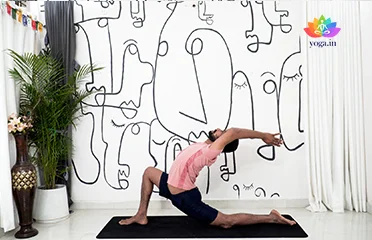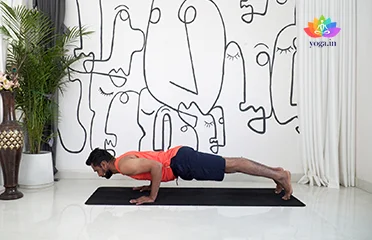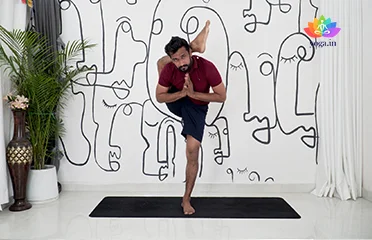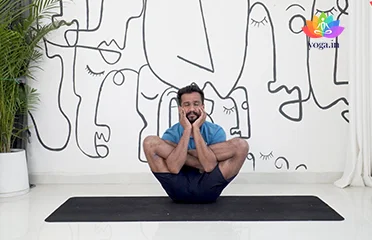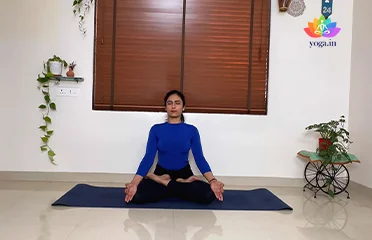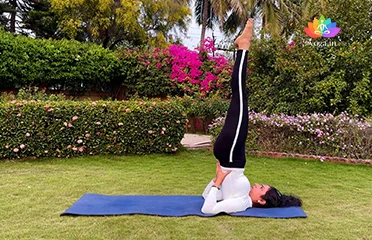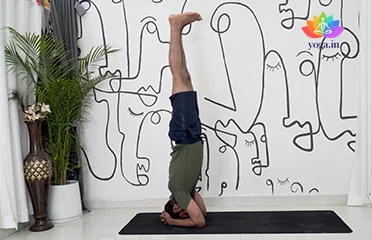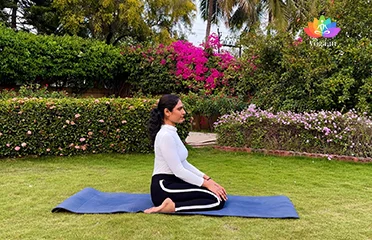Anjaneyasana (Crescent Moon Pose)
आंजनेयासन / Crescent Moon Pose
The Sanskrit name is derived from Anjane (आंजने) meaning Hanuman, [�K]
Chaturanga Dandasana (Low Plank Pose)
चतुरङ्ग दण्डासन / Low Plank Pose
The Sanskrit name is derived from Chatur (चतुर) meaning four, Anga (अङ्ग) [�K]
Durvasasana (Sage Durvasa’s Pose)
दुर्वासासना / Sage Durvasa's Pose
The Sanskrit name is derived from the word Durva (दुर्वा) which [�K]
Garbha Pindasana (Womb Pose)
गर्भ पिण्डासना / Womb Pose
The Sanskrit name is derived from the word Garbha (गर्भ) meaning an [�K]
Padmasana (Lotus Pose)
पद्मासन / Lotus Pose
The Sanskrit name is derived from Padma (पद्मा) meaning lotus and [�K]
Sarvangasana (Shoulderstand)
सर्वाङ्गासनI / Shoulderstand
The Sanskrit name is derived from Sarva (सर्वाङ्ग) meaning all, [�K]
Sirsasana (Headstand)
शीर्षासन / Headstand
The Sanskrit name is derived from Sirsa (शीर्ष) meaning head and asana [�K]
Virasana (Hero Pose)
वीरासन / Hero Pose
The Sanskrit name is derived from Vira (वीरा) meaning hero or a warrior [�K]
Understanding COPD – A Breath of Relief Through Yoga and Lifestyle
COPD (Chronic Obstructive Pulmonary Disease) is a group of lung diseases that make breathing a challenge. The two main culprits? Emphysema, which damages the air sacs, and chronic bronchitis, causing inflammation and mucus buildup in the airways. Both make it difficult to take air in and expel it properly.
What Triggers COPD?
While genetics can play a role, the primary culprit behind COPD is often lung irritation from inhaled substances:
- Smoking: The leading cause, progressively damaging lungs and airways.
- Secondhand Smoke: Even non-smokers exposed to secondhand smoke are at risk.
- Air Pollution: Long-term exposure can irritate lungs and contribute to COPD.
- Occupational Dust and Fumes: Inhaling dust or fumes in certain workplaces can increase the risk.
Symptoms of COPD:
If you experience any of these symptoms, consult a doctor to discuss COPD:
- Shortness of breath, especially during activity
- Wheezing
- Chest tightness
- Persistent cough, often with mucus
- Frequent respiratory infections
- Fatigue
- Swollen ankles, feet, or legs
Managing COPD: Beyond Medications
There’s no cure for COPD, but treatments can significantly improve quality of life. While medication plays a vital role, yoga and pranayama (breathing exercises) can offer complementary benefits:
- Enhanced Breathing: Specific yoga poses, and breathing techniques can strengthen respiratory muscles, improve lung capacity, and ease breathing.
- Stress Reduction: COPD can be emotionally taxing. Yoga and pranayama can help manage stress and anxiety, which can worsen symptoms.
- Increased Strength and Stamina: Gentle yoga exercises can improve overall strength and stamina, making daily activities less demanding.
- Improved Sleep Quality: Yoga’s relaxation techniques can promote better sleep, essential for managing COPD.
Dietary Support for Healthy Lungs
A healthy diet is vital for people with COPD. Focus on these key nutrients:
- Fruits and Vegetables: Packed with vitamins and antioxidants, they fight inflammation and boost immunity.
- Whole Grains: Provide sustained energy and fiber for gut health.
- Lean Protein: Essential for building and maintaining muscle mass, which can aid in breathing.
- Healthy Fats: Sources like fish, nuts, and avocados support lung function and reduce inflammation.
- Hydration: Drinking plenty of water helps thin mucus and improves breathing.
A Gentle Approach to Yoga with COPD
Remember, safety first! Here are some key points to keep in mind when practicing yoga with COPD:
- Start Slowly and Listen: Pay attention to your body. Modify or avoid poses that cause breathing difficulties or discomfort.
- Open Communication: Inform your doctor and yoga instructor about your COPD and any limitations.
- Breathing Techniques: Use proper breathing techniques and avoid holding your breath.
- Don’t Push Yourself: Overexertion can be counterproductive.
Knowing Your Limits: When to Seek Medical Attention
While yoga can be beneficial, there are situations where consulting a doctor is crucial:
- Recent lung surgery or injury
- Severe COPD with respiratory failure
- Uncontrolled high blood pressure
- Certain heart conditions
By understanding COPD, incorporating yoga and pranayama alongside conventional treatment, and adopting a healthy lifestyle, you can take charge of your lung health and experience a significant improvement in your quality of life. Remember, prioritize your safety, listen to your body, and work closely with your healthcare team to create a personalized COPD management plan.


